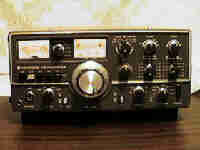

H.SW This is the heater switch for
the tubes. This must be in "ON" position or you will get no
output, but the receiver will work normally. When turned "ON" a
filament will heat the cathodes in the 12BY7A driver and 6146B finals and
electrons will bake off into the vacuum and start to fly to the plate. This
switch is on the rig for mobile/battery operation, since less power is used
if the tubes are not being heated. There seems to be some debate about
whether turning off the heaters when you're not going to be transmitting
prolongs the life of the tubes or not. Some argue the thermal shock of
repeated heating and cooling is worse than just heating all the time. There
are also arguments about how long you should let the tubes warm up before
you start transmitting. I've seen folks advocate everything from 30 seconds
to 3 minutes. The reality is you'll probably flip it on in a panic when you
realize it is off and you want to transmit right now. I've gone as
little as 15 seconds in this situation and it seems to work...
| CAR Carrier Control. Adjusts the
amount of signal applied to the final amplifier. Clockwise to increase.
Though it seems obvious to me now, it took me a while to figure out this is
the "output power control" when using CW. (The "mic"
control in the center does the same thing for SSB.) Bad news is that it goes
from full power to nothing with a tiny amount of counter-clockwise turn and
can be tricky to twiddle with on the fly. The Kenwood manual wants you to
start tune up with this control at 12 O'clock. I usually have it at about 9
O'Clock. It has to be up a little or the S-Meter won't give a reading when
you try to peak the drive (see below).
| Drive Resonates/peaks (tunes) the
grid (input) of the final amplifier, and also the receiver input. Proper
setting will always be somewhere in the middle of the knob setting. A proper
setting for receive will also be right for transmit and vice-versa. Adjust
for loudest static on receive and you'll be in the ballpark for the band and
frequency. You are adjusting the operation of the 12BY7A DRIVEr tube. I
think!
| Plate Resonates the 6146B power amp
tubes -- which means minimum current is coming off the plate and you're not
frying them!
| Load Jim writes: Adjusts the amount
of loading of the final amplifier. Minimum loading = minimum power = knob
turned ccw (to the left). I'm not sure what he means. As I wrote above, the
CAR control varies the CW output power. My understanding is the Load control
runs a small Pi network on the amplifier output that adjusts the final
amplifier output LOADing, and can be used, something like an antenna tuner,
to match the transceiver to the antenna system so you can drive the most
power into it. The Plate and Load controls interact and are adjusted one
after another during tune-up (see below).
| Meter Controls what the meter
displays. (Took me a while to figure out that when the rig is in receive
mode, the meter is always an S-Meter, no mater what this switch is set to.
Also, the receive S-Meter is only accurate if the RF Gain is wide open and
the AGC switch is on "fast" or "slow.") | "ALC" = (automatic level control) amount of drive to final amplifier. Useful in SSB to see your voice peaks (adjusted with the "mic" control. I just realized that AGC (for receive) and ALC (for transmit) are not the same thing! Doh! Scale is the black ALC at the bottom of meter -- the lowest of the scales. "IP" = (current "I" plate) Final amplifier plate current, read on mA scale "RF" = (Radio Frequency power) Relative power output (not a wattmeter, but useful) "HV" = (High Voltage) Final amplifier plate voltage - normally reads about 800V (8 on the red HV scale) |
I guess my current "mental model" of how the these control work goes something like this: CAR/MIC injects the amp, DRIVE peaks up the 12BY7A to juice the finals, and PLATE resonates the 6146 finals and LOAD tweaks the inductance and resistance the final tubes see as they pump RF out of the radio . All these controls interact in various ways, with PLATE and LOAD being the most important, and twitchy!
If you can think of a better/clearer expression for this circuit syllabus lemme know.
The User's Manual (downloadable above) has the "Kenwood Approved" procedure for tuning up the rig starting on page 20. In particular it has a nice chart of initial settings for ALL the controls, which is useful if you have never done this before. The procedure presented here differs in some respects.
Later (October 2002): I've been doing this a lot now, so I have a short version if you understand the basics above, and have an outboard RF wattmeter (like the one in the AT-2x0 antenna tuner series...)
| When receiving CW, turn the AF gain up almost all the way, turn the RF gain down, and turn the AGC off. Use the RF gain for the volume control. This method helps fight QRM and receiver overloading. |